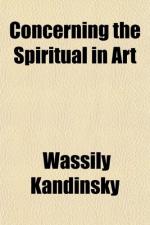Complex rhythmic composition, with a strong flavour of the symphonic, is seen in numerous pictures and woodcuts of the past. One might mention the work of old German masters, of the Persians, of the Japanese, the Russian icons, broadsides, etc. [Footnote: This applies to many of Hodler’s pictures.]
In nearly all these works the symphonic composition is not very closely allied to the melodic. This means that fundamentally there is a composition founded on rest and balance. The mind thinks at once of choral compositions, of Mozart and Beethoven. All these works have the solemn and regular architecture of a Gothic cathedral; they belong to the transition period.
As examples of the new symphonic composition, in which the melodic element plays a subordinate part, and that only rarely, I have added reproductions of four of my own pictures.
They represent three different sources of inspiration:
(1) A direct impression of outward nature, expressed in purely artistic form. This I call an “Impression.”
(2) A largely unconscious, spontaneous expression of inner character, the non-material nature. This I call an “Improvisation.”
(3) An expression of a slowly formed inner feeling, which comes to utterance only after long maturing. This I call a “Composition.” In this, reason, consciousness, purpose, play an overwhelming part. But of the calculation nothing appears, only the feeling. Which kind of construction, whether conscious or unconscious, really underlies my work, the patient reader will readily understand.
Finally, I would remark that, in my opinion, we are fast approaching the time of reasoned and conscious composition, when the painter will be proud to declare his work constructive. This will be in contrast to the claim of the Impressionists that they could explain nothing, that their art came upon them by inspiration. We have before us the age of conscious creation, and this new spirit in painting is going hand in hand with the spirit of thought towards an epoch of great spiritual leaders.
*** End of the project gutenberg EBOOK concerning the spiritual in art ***
This file should be named cnspr10.txt or cnspr10.zip Corrected editions of our eBooks get a new number, cnspr11.txt versions based on separate sources get new letter, cnspr10a.txt
Produced by John Mamoun mamounjo@umdnj.edu, Charles Franks and the Online Distributed Proofreaders Website
Project Gutenberg eBooks are often created from several printed editions, all of which are confirmed as Public Domain in the us unless a copyright notice is included. Thus, we usually do not keep eBooks in compliance with any particular paper edition.
We are now trying to release all our eBooks one year in advance of the official release dates, leaving time for better editing. Please be encouraged to tell us about any error or corrections, even years after the official publication date.




